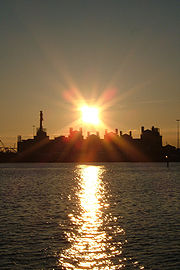
National Oceanography Centre, Southampton
Encyclopedia


National Oceanography Centre
- The National Oceanography Centre :The National Oceanography Centre is a marine science research and technology institution based on two sites in Southampton and Liverpool, United Kingdom...
, and University of Southampton Ocean and Earth Science. The waterfront campus, on Southampton's Empress Dock, was opened in 1996 as the Southampton Oceanography Centre by Prince Philip
Prince Philip, Duke of Edinburgh
Prince Philip, Duke of Edinburgh is the husband of Elizabeth II. He is the United Kingdom's longest-serving consort and the oldest serving spouse of a reigning British monarch....
(he also renamed it the National Oceanography Centre, Southampton, in 2005), NOCS is located near the Ocean Village
Ocean Village (marina)
Ocean Village is a large, mixed-use marina, residential, business and leisure development on the mouth of the River Itchen in Southampton, on the south coast of England. Ocean Village is currently undergoing a major £70m re-development project and is set to become one of the main leisure...
development in the dock area of Southampton
Southampton
Southampton is the largest city in the county of Hampshire on the south coast of England, and is situated south-west of London and north-west of Portsmouth. Southampton is a major port and the closest city to the New Forest...
. It is one of a group of centres specialising in marine science, earth science and marine technology, and provides a platform for interdisciplinary research (such as the Autosub Under Ice programme) alongside a comprehensive teaching facility.
The NOCS comprises the University of Southampton’s Ocean and Earth Science academic unit which operates alongside five NERC research divisions and the NERC's National Marine Facilities Sea Systems . In addition to housing some 520 research scientists and staff, over 700 undergraduate and postgraduate students call the NOCS home. The NOCS's on-site resources include the UK National Oceanographic Library, the nationally important Discovery Collections and the British Ocean Sediment Core Repository. The NOCS is also the base for the purpose-built research vessels RRS Discovery
RRS Discovery (1962)
RRS Discovery is a British Royal Research Ship operated by NERC.RRS Discovery was built in Aberdeen in 1962 and named after Robert Falcon Scott's 1901 ship, RRS Discovery. Until 2006, she was the largest general purpose oceanographic research vessel in use in the United Kingdom...
and RRS James Cook
RRS James Cook
The RRS James Cook is a British Royal Research Ship operated by the Natural Environment Research Council . She was built in 2006 to replace the ageing RRS Charles Darwin with funds from Britain's NERC and the DTI's Large Scientific Facilities Fund...
(and formerly RRS Charles Darwin
RRS Charles Darwin
The RRS Charles Darwin was a Royal Research Ship belonging to the British Natural Environment Research Council. Since 2006, she has been the geophysical survey vessel, RV Ocean Researcher,-History:...
).
Prior to 1 May 2005, NOCS was known as the Southampton Oceanography Centre (SOC). The name was changed to reflect the Centre's prominence in ocean and earth sciences within the UK.
On 1st February 2010 the merger of NOCS and the Proudman Oceanographic Laboratory
Proudman Oceanographic Laboratory
The former Proudman Oceanographic Laboratory is based in Brownlow Street, Liverpool, England. In April 2010, POL merged with the National Oceanography Centre, Southampton to form the National Oceanography Centre National Oceanography Centre...
, Liverpool was announced. The combined institute is known as the National Oceanography Centre. The new combined centre brings together a full range of deep ocean and coastal oceanographic expertise.
On the 25th March 2010 an expedition aboard the RRS James Cook
RRS James Cook
The RRS James Cook is a British Royal Research Ship operated by the Natural Environment Research Council . She was built in 2006 to replace the ageing RRS Charles Darwin with funds from Britain's NERC and the DTI's Large Scientific Facilities Fund...
set out to study the world's deepest volcanic rift. On the 12th April it was reported the expedition had discovered the world's deepest undersea volcanic vents, known as 'black smokers', 5000 metres (3.1 mi) down in the Cayman Trough
Cayman Trough
The Cayman Trough, is a complex transform fault zone pull apart basin which contains a small spreading ridge on the floor of the western Caribbean Sea between Jamaica and the Cayman Islands...
in the Caribbean
Caribbean
The Caribbean is a crescent-shaped group of islands more than 2,000 miles long separating the Gulf of Mexico and the Caribbean Sea, to the west and south, from the Atlantic Ocean, to the east and north...
.

